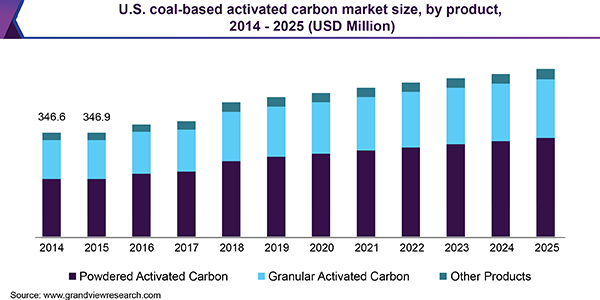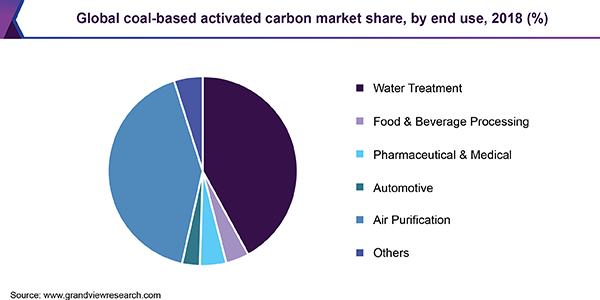- Home
- »
- Water & Sludge Treatment
- »
-
Coal-based Activated Carbon Market Size, Industry Report, 2019-2025GVR Report cover
![Coal-based Activated Carbon Market Size, Share & Trends Report]()
Coal-based Activated Carbon Market Size, Share & Trends Analysis Report By Product (Powdered, Granular), By End Use (Water Treatment, Air Purification, Pharmaceutical & Medical), And Segment Forecasts, 2019 - 2025
- Report ID: GVR-4-68038-011-8
- Number of Pages: 110
- Format: Electronic (PDF)
- Historical Range: 2014 - 2017
- Industry: Bulk Chemicals
Industry Insights
The global coal-based activated carbon market size was estimated at USD 3.4 billion in 2018 and is expected to exhibit a CAGR of 4.3% from 2019 to 2025. The market is driven by its increasing application in air purification and water treatment process. Rising air and water pollution levels as a result of industrialization and urbanization have augmented market growth.
Activated carbon is usually derived from charcoal and processed to make it extremely porous for adsorption and chemical reactions. It is produced by heating charcoal at a high temperature to develop large pores internally. High pore density on the surface is preferred as it indicates high surface area and superior adsorption ability of the product. Other raw materials used in the production of activated carbon include coal, wood, and nutshell.

The U.S. market is characterized by the presence of stringent regulations about air and water pollution. The stricter implementation of these regulations has boosted the application of coal-based activated carbon in mercury removal applications. Also, the product is being increasingly used for impurity removal in the wastewater industry.
Major cities in the U.S., such as New York, Los Angeles, and Chicago, generate large amounts of wastewater due to rural and urban development. Sewage water mainly contains organic, inorganic, and biological pollutants such as suspended solids, pathogens, nitrogen, and phosphorus. These pollutants are potential health and environmental hazards if disposed of directly by landfill.
Air pollution caused by the burning of charcoal is expected to be a major restraint for the market. Stringent policies set by regulatory agencies to protect the environment have resulted in shutting down of various facilities worldwide. Manufacturers have now shifted toward wood-based products owing to ease of manufacturing, thereby negatively affecting the utilization of coal-based activated carbon.
Product Insights
Based on product, coal-based activated carbon is categorized into powdered activated carbon (PAC), granular activated carbon (GAC), and others. PAC is the most widely used product variant, with a market share of 61.0% in terms of volume in 2018. Its differentiated pore structure and superior adsorption capacity make it suitable for a wide range of applications such as pharmaceutical, automotive, and food and beverage industries. It is widely used for the removal of organic contaminants from air and water in industrial and municipal water treatment plants.
Granular is manufactured from organic materials such as lignite wood and coal, which have high carbon content. The primary difference between PAC and GAC is its particle size. The significantly high uniformity coefficient exhibited by GAC makes it suitable for post-filtration applications in the water purification process. It minimizes desorption and premature waste generated from mixing adsorbed compounds with carbon particles. GAC has regenerating properties that makes it popular over other products. It finds utility in air and water treatment plants used for municipal or environment use, metal recovery, food and beverages, medical, industrial process, and mercury recovery.
End-use Insights
Based on end-use, the coal-based activated carbon market has been segmented into water treatment, food and beverage processing, pharmaceutical and medical, automotive, air purification, and others. The water treatment segment is expected to exhibit a volume-based CAGR of 3.8% from 2019 to 2025.
Rising adoption of coal-based activated carbon in small-scale as well as large-scale water systems for removal of chlorine and organic matter is expected to boost the growth over the forecasted period. The industry is now facing a growing challenge from other forms of activated carbon such as wood-based and other synthetic forms.

The pharmaceutical and medical segment accounted for a revenue share of 4.7% in 2018. The purity of raw materials, as well as the finished product, is an essential parameter for the pharmaceutical and medical industry. Coal-based activated carbon helps in providing this purification by removal of color compounds, odor, and other contaminants that are found in raw materials or production by-products. It is widely used in the dialysis machine, nursing supplies, and respiratory equipment for the purification, decolorization, and deodorization purpose.
Air purification is expected to witness the fastest growth over the forecast period. Coal-based activated carbon filters help in the removal of volatile organic compounds (VOCs), odor, and pollutants from the air. The filter traps gas molecules and removes them efficiently with a circular motion.
Regional Insights
The Asia Pacific was the largest market in 2018, accounting for 53.8 % of the global market, in terms of revenue. Rapid industrialization in the region is expected to drive the demand for coal-based activated carbon over the forecasted period. Moreover, government efforts to boost the manufacturing sector in countries such as China, India, and South Korea are likely to fuel the demand for water treatment and mercury removal. Aforementioned factors are thus augmenting the demand for coal-based activated carbon.
In North America, the demand for coal-based activated carbon is expected to witness considerable growth with complete implementation of Mercury and Toxic Standards (MATS) introduced by the United States Environmental Protection Agency (U.S. EPA). The market is highly product-driven, which has facilitated manufacturers to invest in R&D activities for the development of new and improved coal-based products.
In Europe, the production of coal-based activated carbon witnessed a sharp decline in 2017, owing to stringent government regulations on toxic emulsions during the manufacturing process. However, the consumption is expected to grow steadily backed by demand from end-use industries. High awareness regarding pollution hazards, the presence of strict norms and regulations, and high demand from manufacturing sectors are the primary attributes impacting the regional market.
Coal-based Activated Carbon Market Share Insights
The market is highly dependent on the availability of raw material and regulations concerning the usage of coal in commercial applications. The slow growth rate of coal-based activated carbon, coupled with a slowdown in major end-use industries, has resulted in consolidation. Merger and acquisition activity is expected to intensify in the Asia Pacific as regulations are yet to be strictly implemented in developing countries.
Key industry participants include Hangzhou Nature Technology Co., Ltd, Hangzhou Nature Technology Co., Ltd, Shanxi Xinhua Chemical Co., Ltd., Calgon Carbon, and Cabot Corporation. Manufacturers are currently experiencing low utilization rates owing to raw material price volatility, regulations of mining activities, and significant growth of bio-based activated carbon production.
Report Scope
Attribute
Details
The base year for estimation
2018
Actual estimates/Historical data
2014 - 2017
Forecast period
2019 - 2025
Market representation
Volume in Kilotons, Revenue in USD Million and CAGR from 2019 to 2025
Regional scope
North America, Europe, Asia Pacific, Latin America, Middle East & Africa
Country Scope
U.S., Canada, U.K., Germany, China, India, Japan, South Korea, Indonesia, Brazil
Report coverage
Revenue forecast, company share, competitive landscape, growth factors and trends
15% free customization scope (equivalent to 5 analyst working days)
If you need specific information, which is not currently within the scope of the report, we will provide it to you as a part of customization
Segments Covered in the ReportThis report forecasts revenue growth at global, regional, and country levels and provides an analysis of the latest industry trends in each of the sub-segments from 2014 to 2025. For this study, Grand View Research has segmented the global coal-based activated carbon market report based on the product, end-use, and region:
-
Product Outlook (Volume, Kilotons; Revenue, USD Million, 2014 - 2025)
-
Granular
-
Powdered
-
Others
-
-
End-use Outlook (Volume, Kilotons; Revenue, USD Million, 2014 - 2025)
-
Water Treatment
-
Food & Beverage Processing
-
Pharmaceutical & Medical
-
Automotive
-
Air purification
-
Others
-
-
Regional Outlook (Volume, Kilotons; Revenue, USD Million, 2014 - 2025)
-
North America
-
U.S
-
Canada
-
-
Europe
-
U.K.
-
Germany
-
-
Asia Pacific
-
China
-
South Korea
-
India
-
Japan
-
Indonesia
-
-
Central & South America
-
Brazil
-
-
Middle East & Africa
-
Share this report with your colleague or friend.
![gvr icn]()
NEED A CUSTOM REPORT?
We can customize every report - free of charge - including purchasing stand-alone sections or country-level reports, as well as offer affordable discounts for start-ups & universities. Contact us now
![Certified Icon]()
We are GDPR and CCPA compliant! Your transaction & personal information is safe and secure. For more details, please read our privacy policy.
We are committed towards customer satisfaction, and quality service.
"The quality of research they have done for us has been excellent."





